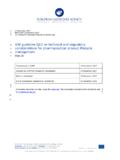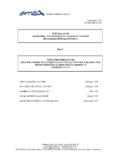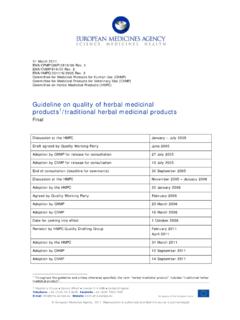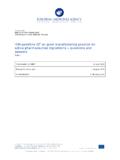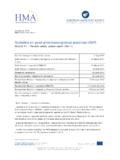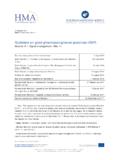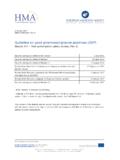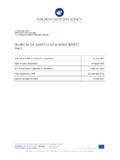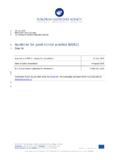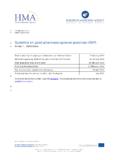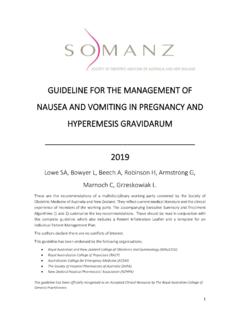Transcription of Guideline on the use of the CTD format in the preparation ...
1 12 March 2013 EMA/HMPC/71049/2007 Rev. 1 Committee on Herbal Medicinal Products (HMPC) Guideline on the use of the CTD format in the preparation of a registration application for traditional herbal medicinal products1 Final Draft agreed by Organisational Matters Drafting Group April 2007 Adoption by HMPC for release for consultation 8 May 2007 End of consultation (deadline for comments) 15 August 2007 Agreed by Organisational Matters Drafting Group 3 October 2007 Adoption by HMPC 10 January 2008 Date for coming into effect 10 January 2008 Draft revision 1 agreed by Quality Drafting Group April 2012 Draft revision 1 adopted by HMPC for release for consultation 22 May 2012 End of consultation (deadline for comments)
2 15 October 2012 Revision 1 agreed by Quality Drafting Group December 2012 Revision 1 agreed by Organisational Matters Drafting Group February 2013 Adoption revision 1 by HMPC 12 March 2013 1 Guidance on modules and 3 as described in this Guideline are also applicable to Herbal Medicinal Product Applications for Marketing Authorisation. Keywords Herbal medicinal products (HMPs) ; traditional herbal medicinal products (THMPs); CTD; traditional use simplified registration; HMPC 7 Westferry Circus Canary Wharf London E14 4HB United Kingdom An agency of the European Union Telephone +44 (0)20 7418 8400 Facsimile +44 (0)20 7523 7455 E-mail Website European Medicines Agency, 2013.
3 Reproduction is authorised provided the source is acknowledged. Guideline on the use of the CTD format in the preparation of a registration application for traditional herbal medicinal products Table of contents Executive summary .. 3 1. Introduction .. 3 2. 3 3. Legal basis .. 3 4. Main Guideline text .. 5 References .. 15 Appendix 1 Guideline on the use of the CTD format in the preparation of a registration application for traditional herbal medicinal products EMA/HMPC/71049/2007 Page 2/15 Executive summary This document aims to provide guidance on how to present the application for registration of traditional herbal medicinal products (THMPs) in the Common Technical Document (CTD) format , providing information to help applicants in their submissions.
4 Revision 1 pertains to the presentation and content of the Module 3 on Quality (chemical, pharmaceutical and biological information) for THMPs to help applicants with their submission. A best practice guide providing further clarification on the exact location of relevant parts of the documentation and the corresponding guidelines in the CTD Module 3 is included as Appendix 1. In addition minor editorial corrections and updates have been introduced in the Guideline itself. 1. Introduction The implementation of the provisions in Directive 2001/83/EC as amended by Directive 2004/24/EC have introduced a simplified registration procedure for traditional herbal medicinal products.
5 Therefore there is a need to develop a common understanding as to how the dossier for such simplified registration applications should be compiled. In addition, in several European Member States there were a number of enquiries from industry regarding the structure of the dossier of applications for traditional use registration. There were especially some issues as to where certain information contained in dossier should be positioned. In general the CTD format should be used in applications for traditional use registration. 2. Scope This Guideline is applicable to applications for traditional use registration of THMPs for human use. The compilation of dossiers for marketing authorisation applications for herbal medicinal products (HMPs) is not covered by this Guideline .
6 However, the guidance provided on modules and 3 including Appendix 1 is also applicable to HMPs applications for marketing authorisation. 3. Legal basis According to Article 16c(1) of Directive 2001/83/EC as amended, the application for traditional use registration of herbal medicinal products shall be accompanied by: a) the particulars and documents: (i) referred to in Article 8(3)(a) to (h), (j) and (k); (ii) the results of the pharmaceutical tests referred to in the first2 indent of Article 8(3)(i); (iii) the summary of product characteristics, without the data specified in Article 11(5)3 [pharmacological properties]; (iv) in case of combinations, as referred to in Article 1(30) or Article 16a(2), the information referred to in Article 16a(1)(e) relating to the combination as such.
7 If the individual active ingredients are not sufficiently known, the data shall also relate to the individual active ingredients; 2 This reads second in Directive 2001/83/EC as amended (amendment through a corrigendum procedure by the European Commission). 3 This reads Article 11(4) in Directive 2001/83/EC as amended (amendment through a corrigendum procedure by the European Commission). Guideline on the use of the CTD format in the preparation of a registration application for traditional herbal medicinal products EMA/HMPC/71049/2007 Page 3/15 b) any authorisation or registration obtained by the applicant in another Member State, or in a third country, to place the medicinal product on the market, and details of any decision to refuse to grant an authorisation or registration, whether in the Community or a third country, and the reasons for any such decision.
8 C) bibliographical or expert evidence to the effect that the medicinal product in question, or a corresponding product has been in medicinal use throughout a period of at least 30 years preceding the date of the application, including at least 15 years within the Community. At the request of the Member State where the application for traditional-use registration has been submitted, the Committee for Herbal Medicinal Products (HMPC) shall draw up an opinion on the adequacy of the evidence of the longstanding use of the product, or of the corresponding product. The Member State shall submit relevant documentation supporting the referral; d) a bibliographic review of safety data together with an expert report, and where required by the competent authority, upon additional request, data necessary for assessing the safety of the medicinal product.
9 Annex I4 of Directive 2001/83/EC shall apply by analogy to the particulars and documents specified in point (a). According to Article 8(3), evoked in Article 16c(1)(a)(i) the application shall be accompanied by the following particulars and documents, submitted in accordance with Annex I4: a) Name or corporate name and permanent address of the applicant and, where applicable, of the manufacturer. b) Name of the medicinal product. c) Qualitative and quantitative particulars of all the constituents of the medicinal product5, including the reference to its international non-proprietary name (INN) recommended by the WHO, where an INN for the medicinal product exists, or a reference to the relevant chemical name.
10 Ca) Evaluation of the potential environmental risks posed by the medicinal product. This impact shall be assessed and, on a case-by-case basis, specific arrangements to limit it shall be d) Description of the manufacturing method. e) Therapeutic indications, contraindications and adverse reactions. f) Posology, pharmaceutical form, method and route of administration and expected shelf-life. g) Reasons for any precautionary and safety measures to be taken for the storage of the medicinal product, its administration to patients and for the disposal of waste products, together with an indication of potential risks presented by the medicinal product for the environment.
